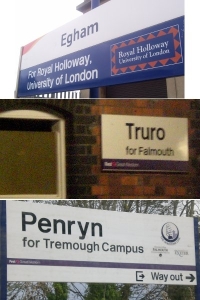Guest Post: A repository journey for the creative arts
October 27, 2011 1 Comment
This guest post is authored by Kim Coles, Information Assistant (Digital Collections), Royal Holloway, University of London. As announced last week, during October 2011 the RSP sponsored ten UK repository staff ‘buddy visits’ as part of our Open Access Week initiative. Further information available from here. Kim visited University College Falmouth who are currently designing an institutional repository which will be connected to their online research community.
Theme: Archiving and presenting arts research outputs
 In between two rather epic train journeys (across beautiful scenery) on Wednesday 19th and Thursday 20th October, I visited the Tremough Campus of University College Falmouth (UCF) and Doreen Pinfold, Tom Readings and Tim Shear, who work in the Library and Technology Enhanced Learning Teams respectively. My original proposal was an investigation into new ways to archive arts research – thinking creatively about how the repository can work for and with researchers.
In between two rather epic train journeys (across beautiful scenery) on Wednesday 19th and Thursday 20th October, I visited the Tremough Campus of University College Falmouth (UCF) and Doreen Pinfold, Tom Readings and Tim Shear, who work in the Library and Technology Enhanced Learning Teams respectively. My original proposal was an investigation into new ways to archive arts research – thinking creatively about how the repository can work for and with researchers.
Why UCF?
The team are looking into ways of archiving arts research which is linked to the production process – in fact they have worked the research process into their planning so that the whole procedure becomes organic. They are designing an institutional repository which is connected to an online research community, the AIR Portal. This aids dialogue between researchers as well as these external users, and it is therefore easy to discuss and produce work within the AIR portal which will eventually be deposited into the repository with a single click as part of the production process.
This is a method of digital preservation which ‘makes official’ the research outputs. Where the Portal is a space for production, the repository will be a way of exhibiting what is produced via Open Access, whether this is a finalised product or a snapshot of the continuing research as it stood at one point in time.
This is a different and unique way to create and manage a repository, and so seemed the ideal choice for a visit.
So where is the repository?
UCF’s repository is not up and running, and so I had a lot of questions about how one goes about designing a repository from scratch.
I found it interesting that although the team want to design according to need, they are taking a very measured and structured approach. Currently they have the opportunity to compare current repository software for functionality; allowing them to choose the parts which are useful, suggest for development those which need improvement, and suggest new archiving ideas to their researchers.
Time can then be dedicated to producing something which encompasses the best of these areas and, crucially, will be backed up by good metadata standards and a sound technical base which can be adapted in the future. Then, they can trial a useable test version of the system to small groups from each school of study, to report back on. This feedback received, further work will need to be done in order to tailor the systems further, and this may happen multiple times before the finished system is released across the college.
The advantage of UCF’s measured design strategy is that they firstly do not confuse researchers with vastly different versions and functions, but also that they can provide consistent clear message about archiving throughout while at the same time producing a system which meets researchers’ needs.
Conclusion
In answer to my proposal questions, it is clear that the repository at UCF is/will be interactive, dynamic and tailored to the needs of their arts researchers. But what struck me most about the team at UCF was not only their knowledge of the subject area, but their enthusiasm, interest and excitement about what they were producing. There are a lot of opportunities available and UCF seem very much open to them.
This is an attitude which I feel could especially useful to us at Royal Holloway as we move into a six-week promotional campaign to encourage engagement with our repository and CRIS. If we take constructive criticism and ideas as suggestions for improvement instead of complaints, then we could move forward and produce something applicable to our researchers’ needs. By constantly asking opinions but retaining a strong backbone, the repository can remain consistent in its aims while editing the manner in which it achieves them. Of course, we will need the support of out IT team to do this, but by returning to a ‘shared services’ approach we are able to discuss these ideas with those who have the technical know-how: vital for the development of our repository. This development could be as dramatic as a total overhaul and redesign, or as simple as offering to educate more and differently to tailor our approach as needed.
There’s a lot of food for thought here as it is, but I have to say, it was very difficult to cut this down to a readable length, so if there are any questions, please feel free to comment!
Lastly, though, I’d like to thank Doreen, Tim and Tom for their generosity and a really lovely visit to University College Falmouth.
Author: Kim Coles, Royal Holloway, University of London

Pingback: Guest Post for the RSP « Nouveau Librarian